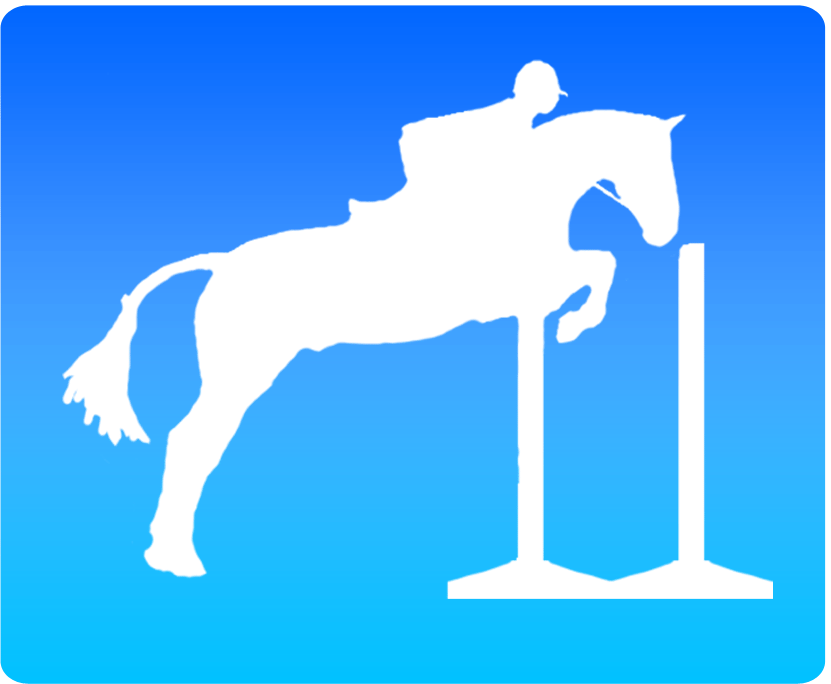top of page
MEDAL MACLAY • HUNTER SEAT EQUITATION RESOURCE

What is Equitation?
Popular with young equestrians and amateur riders, hunter seat equitation is a type of horse show class which encourages riders to learn proper horsemanship and riding skills, with an emphasis on the form and function of the rider. Many American show jumping riders developed their skills in equitation classes before going on to represent the United States at the Olympics and other international show jumping events.
In order to understand what equitation is, it is necessary to learn the basics about the hunter/jumper sport. This article explains the basics and is aimed at the general public who might like to learn more on the subject. For official definitions of terms and rules, please refer to the United States Equestrian Federation (USEF) rule book at www.usef.org, the national show association which presides over most competitions. In addition, the United States Hunter/Jumper Association (ushja.org) oversees the sport as part of USEF.
What does hunter/jumper mean?
“Hunter/Jumper” refers to a specific equestrian discipline or style of riding where horses are ridden English style and jump over a series of obstacles, also called fences or jumps. A series of fences is called a "course." Hunter seat equitation is a specialty area of the hunter/jumper discipline.
Within the discipline there are three distinct sub disciplines: hunters, jumpers and equitation. The two terms “hunter/jumper” are often used synonymously because today's horse shows offer classes in both sub disciplines to accommodate competitors, as well as the third less common sub discipline, equitation.
In a nutshell, hunters show over simplified courses meant to mimic traditional hunt field obstacles and the judging is subjective. In general, judges are looking for horses that are well mannered, athletic and attractive to ride safely and smoothly over the fences.
On the other hand, jumpers ride over technically difficult courses that tend to twist and turn. The judging is objective and mathematical based on whether the horse knocks down a fence, stops at a fence or does not complete the course in a certain time limit. All of those mistakes incur "faults" or penalties. The horse with the fewest faults and the fastest time taken to complete the course wins the competition.
Equitation, is a hybrid between hunters and jumpers, where the rider’s abilities are judged subjectively over a more difficult jumper type course.
Is this the same as 'stadium jumping' or 'show jumping'?
Yes. Those terms are generally applied to the jumper sub discipline. The ultimate goal of many serious competitors, particularly riders who specialize in the jumper discipline is to reach the top of the sport at the grand prix level. Here horses and riders compete over large courses of fences as high as five feet tall or higher in national and international show jumping competitions, such as the Olympics or World Championships.
About Horse Shows
Horse shows are gatherings of hundreds, sometimes thousands of horses and riders to compete. Most horse shows are held on one day. These are called local shows or “B” shows if they are associated with USEF/USHJA, the national horse show associations. Riders, horses and trainers rise early to travel and compete at these shows. They bring their horse in a horse trailer for the day and go home after competition.
There are also multi-day competitions, usually given a rating of “A” or “AA” by USEF. At multi-day shows, riders, horses and trainers travel to a showground and stay for two or more days. The horse show management sets up temporary stabling where the horses will live during the competition, while competitors and trainers stay at nearby hotels or motels.
Often hunters and jumpers show in “divisions” or a series of classes where horses accumulate points in an effort to win a championship. These divisions can be divided by many criteria, including but not limited to horse/pony size, rider age, horse’s training level, jump height, etc. A typical division has three or more classes. In every class, ribbons are assigned point values with first being the most. The points earned from the classes accumulate towards the championship, and the horse and rider with the most wins the championship.
Horses and riders can compete in a jumping, or over fences, class or a flat class. In over fences classes, the horses compete one at a time and demonstrate their skills over a series of jumps. In flat classes, all of the horses are gathered in the ring and judged in a group at different paces- walk, trot, and canter.
Awards and Ribbons
At one day horse shows, usually class ribbons are awarded for first through sixth place. At multi-day “A” shows, ribbons are generally awarded for 1st through 8th place. In special classes, ribbons can be awarded beyond 8th place. Trophies are often given, but they vary from show to show. Traditional trophies are generally engraved silver cups, bowls, plates and trays.
In the United States blue is first place, red is second place, yellow is third place, white is fourth place, pink is fifth place, green is sixth place, purple is seventh place, brown is eighth place, grey is ninth place and baby blue is tenth place. Championship ribbons are tri-colored: Champion is blue, red and yellow; Reserve champion (essentially the championship runner-up) is red, yellow and white.
What is a hunter?
Hunters compete in classes where the horse is judged subjectively by one or more judges. In both jumping and flat classes, each horse is judged on: “Performance and soundness [whether or not the horse appears to be lame]...” (US Equestrian Article 2423).
In some classes the horses are judged on more specific features, such as "conformation, suitability and manners." (US Equestrian Article 2423). Conformation refers to how a horse is put together, i.e. whether he has a desirable and functional physique.
Suitability refers to the horse’s natural capabilities for the tasks being asked to perform. For example, a horse which jumps unsafely would not be considered a “suitable” hunter in a hunter over fences class.
Manners refers to the horse’s temperament, and how he responds to a rider’s instructions. For example, a horse that kicks out when asked to begin trotting would not have good manners, while another which perks his ears alertly and is obedient will be rewarded for good manners.
Hunter divisions at horse shows are divided into numerous categories. Some include “green” hunters for inexperienced horses, conformation hunters where horses are judged on their performance with extra emphasis placed on the horse’s physical build, performance and working hunters with large fences for experienced horses, and pony hunters for ponies (horses under 14.2 hands tall) only. Other divisions can be divided by the status of the riders who pilot the horses around the course, such as junior hunters for riders 18 and under, amateur-owner hunters for non-professional adult riders or short stirrup hunters for young children just learning to ride.
A typical hunter course is 8-10 fences consisting of natural colored jumps, set on straight lines at various points around the ring. Some of the fences are set at related distances and are meant to be ridden as a set with a specific number of strides, or canter steps, in between them.
Hunter Derbies are often offered at horse shows. These special classes are independent of regular divisions. They are generally held on large rings or fields and usually consist of longer, more complex courses. Derbies are usually two rounds, with the winner determined by the cumulative scores from both rounds.
What is a jumper?
Jumpers compete in classes that are judged objectively. This means that they are not judged on style. As a horse jumps around a course, the goal is to jump all of the fences without knocking any rails over. A horse incurs 4 faults for every refusal, 4 faults for each rail knocked off a jump, and 1/4 fault for every second past the time allowed they were given to complete the course. Basically it can be pretty or ugly, but as long as all the jumps are left standing the horse has been successful. There are many different types of jumper classes.
In some classes, if the horse has a “clean” first round, (that is, they had no rails or faults), then they may continue directly to the second round, or shortened jump-off course; other "speed" classes are automatically judged on the fastest time with faults converted into seconds added onto the time. In other classes, the horses that were clear will exit the ring and return after the close of the first round for the jump-off.
All courses are timed, and in both rounds, time is the tie-breaker with the faster horse given preference. So in a jump-off, if two horses have 0 faults, then the one with the fastest time will win.
Like hunters, the various jumper divisions are divided by categories. Some include “young” jumpers for inexperienced horses. Other divisions can be divided by the status of the riders who pilot the horses around the course, such as junior jumpers for riders 18 and under, amateur-owner jumpers for non-professional adult riders or pony jumpers for children.
A typical jumper course is 8-12 fences consisting of natural as well as brightly colored jumps. Unlike hunters, jumper courses tend to twists and turn. Some of the fences are set at related distances and are meant to be ridden as a set with a specific number of strides, or canter steps, in between them. In jumpers, the horses also often are asked to jump water ditches and other more difficult obstacles.
What is equitation?
Equitation classes are a hybrid between hunters and jumpers. It is similar to jumpers in that riders often have to compete over jumper type courses, but it is more like hunters because it is also subjectively judged on the rider’s style. While the horse itself is not being judged, it can greatly influence how the rider looks and is perceived by the judge.
The majority of equitation classes offered are for junior riders. This stems from the fact that equitation is considered a good teaching tool in preparation for the upper level jumper divisions. It helps riders to learn to position themselves and ride correctly over difficult courses.
Equitation classes begin at the lowest levels of competition, with short stirrup and lead up to the USEF Talent Search Final, used to seek out the most talented young riders for future international competition. Equitation is one of the most popular junior divisions, with major national finals drawing hundreds of riders every year.
When equitation classes began to be offered in the United States in the 1930s, riders were awarded medals for their achievement in winning a class. The nickname for equitation classes as 'Medal Classes' has stuck years later. That nickname, along with the newer phrase, 'the big eqs' refer to the classes which riders show in to qualify for several national championships, especially the historic and coveted USEF Medal and ASPCA Maclay Championships. Those championships as well as several newer national year-end competitions are referred to as 'Finals.'
Equitation divisions at horse shows are very popular for junior and pony riders, aged 17 and under, as well as for amateur adult riders 18 and over. The evidence of the growth of the division has been seen in the creation of many new equitation championships, both on a regional and national level. Originally, junior riders focused their energy on just the two major 3'6" medal classes: the USEF Medal and ASPCA Maclay. That all changed with the creation of numerous new championships, including the United States Equestrian Team Talent Search Final in 1982 and the Washington International Horse Show Equitation Classic in 1994, which have both become top tier national finals. Amateur riders simply had no national medal classes to ride in at all until the 1990s. The Capital Challenge Horse Show tapped a new market for equitation offering 3'0" finals for children (National Children's Medal starting in 1994) and amateur riders (National Adult Medal begun in 1995).
What's the difference between children's medal and junior medal classes? A "children's" medal class is a level below the "junior" classes according to fence height. They available to junior riders who are competing over fences that are 3' tall. Generally younger kids under 14 compete in them. A "junior" medal is usually six inches higher, at 3'6" and some are even 4' tall. Similarly, young kids ride in "pony" medal classes on their ponies before moving up to the children's medal, and then eventually the junior medal level. Adult amateur medal classes are generally 3'0" or lower in height.
Professionals don’t have an equitation division: they are using their equitation skills already in showing upper level hunters and jumpers.
Competing in equitation classes requires extensive training and practice with an equestrian professional. Many riders begin training in their youth, spending years in the saddle to gain the experience necessary to compete at one of the year-end finals. Though the cost of competing is high, there are opportunities for all riders to compete more today than ever before. There are literally so many finals being offered, that riders can pick and choose based on their geographic location or their level of skill. Many regional horse show associations offer beginner medal classes through junior and amateur medal classes. At the highest levels of equitation, junior riders tend to always seek qualification for the prestigious USEF Medal and the ASPCA Maclay, but beyond that they have the option of choosing whether to do the USEF Talent Search, North American Equitation Championships, the Washington class or any of various local or regional 3'6" medal finals.
Why participate in horse shows?
It’s fun! Win or lose, it’s fun to go someplace new and test one’s skills. Many horses and riders spend hours each week honing their skills at their training stable in riding lessons. Showing is a good way for riders to evaluate their progress individually and ability relative to their peers. Some riders find satisfaction in showing for practice and experience.
For some, horse shows create temporary communities, and the social aspect of competing and spending time with friends is a draw. Others show to qualify for championships or year-end finals and awards. Trainers bring sale horses to shows to market them. The reasons for showing are diverse.
Typical show day
A tremendous amount of behind the scenes effort takes place to make every horse show happen. From the rider/owner perspective, it involves a lot of work. Some show barns hire grooms to aid riders with everyday care. Riders may also choose to do everything by themselves, whether to save money, or for the satisfaction of caring for a horse. Of course, everyone's show experience will be different. Either way, showing is time and effort intensive.
A typical show day can start as early as 3 or 4 am, when the horses are braided for the show day. For hunter and equitation divisions at “A” shows, it is appropriate to braid a horse’s mane. In hunters, the tail is braided as well. No braiding is necessary for jumpers, since they are not being judged on appearance. Depending on the skill of the braider, it can take 20 minutes to an hour to braid a horse’s mane.
Early morning brings general horse care. Whether on the road in temporary stabling, or at home, the horses must be fed, given fresh water, and have their stalls cleaned. If the rider is going to a one day show, then the horse's legs must be wrapped in protective traveling bandages, and loaded onto the horse trailer with all the show equipment and supplies.
Show warm-ups are generally in the early morning hours anywhere from 5-8 am depending on the show. Horses that need extra practice get ridden before the show. Classes and competition begin in the morning and continue into the afternoon, and sometimes early evening depending on the show size. Before classes, a horse must be brushed or even bathed to be clean for presentation in the show ring. In addition, the tack, including the saddle, bridle, girth and leg boots must be cleaned.
As the approximate time to compete draws near, the horse will be saddled and bridled. Once in the saddle, a rider will spend anywhere from 20 minutes to an hour riding and preparing to compete. A trainer will help a rider "warm-up" in a practice arena near the show ring. Once warmed-up, the horse and rider will show in one or a handful of classes.
After competing, there’s even more work to be done. Cooling the horse down by walking, untacking the horse, bathing and/or brushing, unbraiding, wrapping their legs’ with support bandages. Then there’s more basic care, getting the horse fed and watered again and transported back home and unpacking the trailer.
After everything, it’s likely that the part of the day that goes by the quickest is the two minutes spent on course competing. Most riders will swear it’s absolutely worth it for the thrill of flying over some fences on a beloved horse or pony!
How to get into horse showing
The best way to get into horse showing is to take riding lessons and find a barn that offers horse show coaching as part of its services. Horse shows offer divisions for every level from beginner on up, thus all a rider needs is a barn which has show horses and show services available to customers. Many stables even offer local one-day horse shows on their farm. There are many opportunities for riders of every background to get involved and compete. Finding a barn and trainers that will work with you and your budget is important. One way to locate a barn in your area is to contact a local horse show association.
Watching a horse show
Another good way to get involved in horse showing is to go and watch some shows. Over time one can learn all the subtleties of showing, why one rider wins over another, or why one horse wins over another.
One important aspect to watching and understanding an over fences class is the concept of a distance. A “distance” is a different way to say take-off spot. It is the place where the horse takes off from in relation to the fence. If a horse takes off too close to the jump, it will look awkward and out of place, as though he popped over it. On the other hand, if the horse takes off too far away, it can cause gasps from onlookers, as they wonder if the horse will clear the fence.
As long as the horse clears the fences in a jumper competition it does not matter what it looked like. But both a long distance or a short distance are faults in judged hunter and equitation competitions. A horse that clears all the fences taking off from a good middle range distance will appear smooth and in control, and will likely win the class.
To find a show to watch, USEF has a listing of horse shows and one can search by state. In the winter, the majority of shows are held in warmer climates, such as Arizona, California, and Florida. During the summer months, one can probably find a horse show every weekend to go watch that is within a reasonable drive. With the advent of video sharing online, there are now tens of thousands of videos from horse shows available where you can also learn about the sport and the divisions you're interested in pursuing.
Helmets
A rider’s most important piece of riding equipment is no doubt the helmet. Riding is inherently dangerous, because horses are big animals and unpredictable. While fatal accidents are rare, it is best to guard against the worst. USEF has information on helmets that have been approved as safety helmets.
How are riders categorized in different divisions?
Every rider that shows must be classified by age or professional designation:
• Junior - riders ages 17 and under.
• Young Rider - riders 21 and under, professional or non-professional
• Amateur - riders aged 18 and over, non-professional.
• Professional - riders 18 and over who rides, trains or in some way makes money working with horses. (See USEF website for specific definitions of amateurs and professionals.)
Typical Hunter/Jumper Breeds
Jumping capability is quite individualized to the horse, so any breed is suitable so long as the horse is good at jumping. The majority of showjumpers are Warmbloods and Thoroughbreds.
Typical Horse Sizes
Human height in the U.S. is measured by feet and inches. Horses, on the other hand, are measured in a different way. They are measured in units called "hands." A hand is 10 cm or 4 inches. A popular assumption might be that a horse is measured by how tall his head is. In reality, horses are measured by the height of their "withers," a part of the spine at the base of a horse's neck, just in front of the area where the saddle is placed. Ponies are 14.2 hands and under, while horses are 14.3 hands and above.
Horse Show Circuits & Series
Sometimes several horse shows are held in one location over a period of weeks. These are called "circuits." Some examples of circuits are: The Winter Equestrian Festival in Florida every winter, or the HITS Desert Circuit held in California. Regional show associations or horse show companies might also offer a "series" of shows where horses and riders accumulate points for year-end awards, though the shows might not fall in succession each week.
Championships, Major Competitions, & Year-End Awards
Every sport has it’s Super Bowl, World Series or Stanley Cup. For hunter/jumpers on an international level there are many prestigious competitions. At the head of the list are the Olympics, the World Championships, and the World Cup. Other major international competitions are Spruce Meadows in Canada., Hickstead in England, and Aachen in Germany, to name a few.
Domestically, the Winter Equestrian Festival in Wellington, Florida, the HITS Ocala circuit in Ocala, Florida, and the HITS Desert Circuit in California showcase the best in hunter/jumpers every winter. The most prestigious individual horse shows are ones such as The Devon Horse Show in May, and the fall indoor horse shows which host many national finals: The Capital Challenge Horse Show, The Pennsylvania National Horse Show, The Washington International Horse Show and the National Horse Show. USEF also puts on the National Pony Finals, the National Junior Hunter Finals and the North American Young Riders competition, held every summer for young equestrians.
For equitation, the most important shows and competitions are the ASPCA Maclay Regionals, the USEF Talent Search Finals East and West, the North American Equitation Championship, Washington International Horse Show Equitation Classic, the USEF Medal Finals, and the ASPCA Maclay Finals. Many individual horse shows also have prestigious equitation classes, with circuit championship classes at the three winter circuits, and the equitation championship at Devon. There are also numerous local and regional equitation finals held each fall which are hosted by local horse show associations.
Horses and riders may also accumulate points towards year-end awards, which are presented annually by USEF. The awards are given both at the local level, within 12 geographic "zones" designated by USEF, as well as national awards. Typically, equitation divisions are not included in year-end awards by USEF, except for in adult equitation. Most championships are decided at equitation finals - specific events that detemine the year-end champion.
We hope you have found this guide to be informative and that it helped you to understand this sport better. We wish you luck as you continue to pursue your interest in horses. This guide is not meant to be an official guide to hunter/jumpers or horse shows. It is an attempt to explain the basics of the hunter/jumper discipline and horse showing to the general public who might find an interest in the subject For official definitions of terms and rules, please visit USEF.
bottom of page






